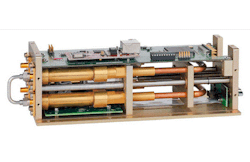Among the different delay lines from Colby Instruments on display at EDI CON 2016, the PDL-100A series of programmable delay lines features a wide frequency range of DC to 18 GHz. The programmable delay lines employ the company’s unique electromechanical trombone delay-line structures. The base model PDL-100A-625.0PS delay line provides delays from 0 to 625 ps over the full frequency range with 1 dB or less insertion loss; additional models in the series achieve as much as 100 ns delay time.
Although this is an electromechanical design, it features tuning resolution as fine as 0.5 ps with excellent reliability: typical recommended service intervals are for 500,000 operations. The delay line offers 0.1% precision with typical accuracy of ±0.2 ps. The delay lines are programmable via GPIB (IEEE488.2 protocol), Ethernet TCP/IP, or RS-232 serial interfaces or via optional model MT-100A microterminal. These delay lines have been used for non-return-to-zero (NRZ) testing at rates to 40 Gb/s.
About the Author
Jack Browne
Technical Contributor
Jack Browne, Technical Contributor, has worked in technical publishing for over 30 years. He managed the content and production of three technical journals while at the American Institute of Physics, including Medical Physics and the Journal of Vacuum Science & Technology. He has been a Publisher and Editor for Penton Media, started the firm’s Wireless Symposium & Exhibition trade show in 1993, and currently serves as Technical Contributor for that company's Microwaves & RF magazine. Browne, who holds a BS in Mathematics from City College of New York and BA degrees in English and Philosophy from Fordham University, is a member of the IEEE.


